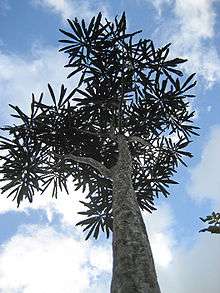Pseudopanax crassifolius
| Pseudopanax crassifolius | |
|---|---|
 | |
| Adult tree | |
| Scientific classification | |
| Kingdom: | Plantae |
| (unranked): | Angiosperms |
| (unranked): | Eudicots |
| (unranked): | Asterids |
| Order: | Apiales |
| Family: | Araliaceae |
| Genus: | Pseudopanax |
| Species: | P. crassifolius |
| Binomial name | |
| Pseudopanax crassifolius (Sol. ex A.Cunn.) C.Koch | |

Pseudopanax crassifolius, horoeka, or lancewood, is a New Zealand native tree belonging to the family Araliaceae. It is found throughout New Zealand from sea level up to about 750 m. The juvenile form, which lasts for between 15 and 20 years, is very easily recognized. The leaves are stiff and leathery with a prominent central rib, about 1 cm wide and up to 1 m long with irregular teeth, all growing downwards from a central stem. The young trunk has characteristic vertical swollen ridges. As the tree gets older the stem begins to branch producing a bushy top, and the leaves become wider and shorter, losing their teeth. It is only when the tree is mature that it adopts a typical tree shape.
One of the theories about this curious change of appearance is that the young plant had to protect itself against browsing by the moa, the giant flightless bird that roamed New Zealand's bush in prehistoric times. Once above moa height, it was out of danger and turns into a "regular" tree. A study of leaf colour development in P. crassifolius found that leaves of seedlings would blend with leaf litter, while juvenile leaf colouration would draw attention to their spines. A closely related Chatham Island species, which evolved in the absence of moa, did not display these changes.[1]
Closely related is Pseudopanax ferox, the toothed lancewood. It is similar to P. crassifolius except the leaves are more abundant and severely toothed, resembling a bandsaw blade.
In fiction
The New Zealand lancewood features in a World War II novel titled Lancewood, by Alan Marshall. A paragraph from Chapter 3 reads:
"A bizarre jagged gem of the forest, the lancewood's distinctive habit splits the soft forest light to stab one in the eye with an odd, unearthly beauty. It's slicing leaves, each blade a blade, gives the plant the demeanor of a strangely elegant weapon."
External links
- Flora of New Zealand, URL:Pseudopanax crassifolius. Accessed 17 May 2007.
- New Zealand Plant Conservation Network, URL:Pseudopanax crassifolius. Accessed 2010-10-04.
![]() Media related to Pseudopanax crassifolius at Wikimedia Commons
Media related to Pseudopanax crassifolius at Wikimedia Commons
References
- Salmon J T, The Native Trees of New Zealand, AH & AW Reed Ltd, Wellington, New Zealand, 1973. ISBN 0-589-01340-8.
- Alan Marshall, Lancewood, Indra Publishers, Australia, 1999. ISBN 0-9585805-1-0.
- ↑ Fadzly, N.; Jack, C.; Schaefer, H.M.; Burns, K.C. (October 2009). "Ontogenetic colour changes in an insular tree species: signalling to extinct browsing birds?". New Phytologist. 184 (2): 495–501. doi:10.1111/j.1469-8137.2009.02926.x. PMID 19674327.